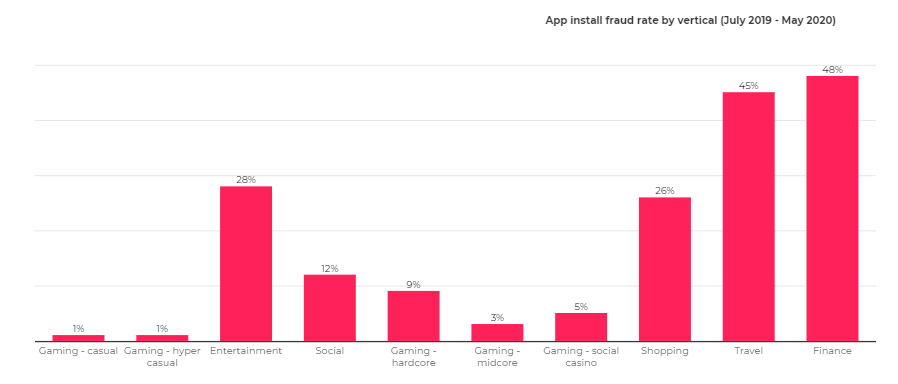Mobile app fraud costs the industry millions, possibly even billions of dollars each year. While the industry has made significant strides to combat it, fraudsters still look for any opportunity to exploit the system. These bad actors attempted to take a cut of the app frenzy that occurred in the first part of 2020 due to the pandemic.
To explore the trends, we looked at two reports on the subject, covering the first half of 2020 from AppsFlyer and a full review of 2020 ad fraud from Opticks. The AppsFlyer report concluded that there was financial exposure of $1.6 billion related to install fraud. The bulk of this, $945 million, was in the APAC region.
Which Has Better Protection: iOS or Android?
iOS is the leader in fraud protection, but it’s not so black and white. Android has a larger market share and greater global reach, meaning there’s more opportunity for fraudsters. As a result, Android’s fraud rate is 4.5 times higher than iOS.
Overall, most apps have strong protections in place because of the greater awareness around fraud, but bad actors are still finding weaknesses.
What Apps Have the Greatest Risk of Install Fraud?
If you guessed gaming, you’d be wrong. It seems like it would be, but not according to the numbers. Finance, travel, shopping, and entertainment were the leaders in install fraud. One in four non-organic installs in non-gaming are fraudulent!
Why these verticals? Finance and travel typically have higher cost per install (CPI) rates and larger budgets, which makes them attractive. Conversely, gaming apps have highly sophisticated tools and are more proactive around install fraud.

Image: AppsFlyer
What Are the Most Common Mobile App Fraud Methods?
Bots are the fraud weapon of choice for cyber-criminals. Bots automate fraud, so it makes their job easier. They create fake users instead of stealing the identity of real users to prevent exposure. They can scale fast and do serious damage.
Hijacking is still prevalent and happens most often in gaming. Click flooding is another tactic. It occurs when networks intentionally report a large number of fraudulent clicks to take “credit” for the final click before the install.
Keep in mind that these fraudsters are becoming more inventive and sophisticated. It’s not just a nuisance; it’s big business to these groups.
The Rise of Mobile Malware on Google Play
The Opticks report included a special section on mobile malware. The scheme is to drive fraudulent traffic to campaigns using several methods:
- App masking: Bad actors “mask” a fake app package by spoofing, so it appears legitimate.
- Sending traffic from suspicious apps outside the Google Play Store that were either banned or never joined. This is a fraud red flag.
Mobile Ad Fraud Trends: What to Expect
We’re never going to eliminate fraud as an industry. The problem is too big and complex. However, vigilance and being proactive are critical. The likely trends for this year and beyond include:
- Install fraud will continue, but bad actors see new opportunities with in-app fraud activity. Apps are running more of these campaigns to reduce churn and boost retention.
- It doesn’t matter where you or your users are; fraud doesn’t have borders. It’s a virtual world, and fraudsters will seek out weaknesses anywhere.
- The new opt-in attribution model on iOS and the retirement of IDFA could be a catalyst for ore install fraud. Advertisers will have less available information on users. As a result, it may be harder to identify fraud.
- Those verticals most susceptible will continue to be targets without strengthening their protection layers.
AdAction’s Defense Against Mobile App Ad Fraud
Overall, fraud is declining and so is preventing it. That’s one of the pillars of our programs. We take mobile app fraud seriously and have specific technology to protect against it. We monitor campaign traffic worldwide in real-time to identify and tag suspicious activity at the source and user level. Our stance is to be proactive in fighting fraud.
Additionally, we belong to the industry working group, Coalition Against Ad Fraud (CAAF), helping to educate and address mobile ad fraud. We’ve been recognized for our efforts by earning a spot on the 2021 Singular ROI Global Fraud Leaders for Android list, as well.
If you have questions about ad fraud, contact our team today.



